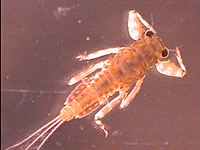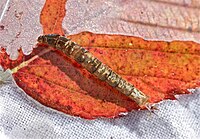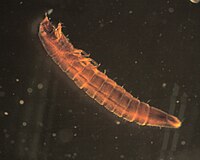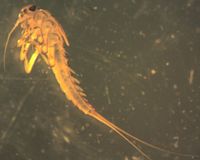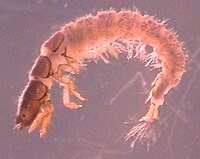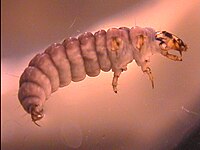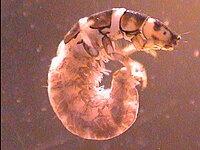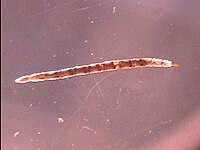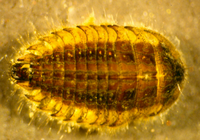Beaver Brook
From WikiEducator
| Stream code: | DR_BeavBrk_1524 |
| Basin: | Deerfield River |
| State or Province: | Vermont |
| Country: | USA |
| Latitude: | 42.86533378 |
| Longitude: | -72.85924426 |
| School: | Twin Valley Union High School |
The following are the most common invertebrates collected from this stream site.
Contents
Chironomidae
Midge larvae tend to be the most common macroinvertebrate at our sites. As with other Diptera, there are no true jointed legs. Chironomidae do have a pair of prolegs at each end and preserved individuals tend to curl into a 'C'. Identification past family requires slide-mounted heads. We have seen philopotamid caddisflies misidentified with the chironomids and we suspect that that happens when samples are being sorted from trays. Under a microscope, six prominent legs can be seen on members of the caddisfly family Philopotamidae.
More information on Philopotamidae.
Ephemerella
- Order
- Ephemeroptera
- Family
- Ephemerellidae
- Genus
- Ephemerella
- Common name
- The Hendrickson; The Red Quill; The Hendrickson Spinner Fall
- Tied fly
- Hendrickson; Flick's Red Quill; Lunn's Particular
Mayflies in this genus have long intersegmental setae on their cerci that extend laterally and may or may not have whorls of spines at the end of each segment of their cerci. Their maxillary palps are well-developed.
Image of the intersegmental setae.
Hexatoma
This Tipulidae can be identified by the swollen 7th abdominal segment. The swelling is bulbous and frequently as much as 2X abdominal diameter in preserved specimens.
Stenelmis
The larvae of Stenelmis, as in Ordobrevia, have a sternum on the ventral side of the pronotum. The main difference between the two genera is in the antennae the second segment is less than twice as long as the first in Stenelmis.
The adult Stenelmis has a clear separation between the thorax and abdomen as well as a more distinctly separate head as compared to other genera.
Baetis
- Order
- Ephemeroptera
- Family
- Baetidae
- Genus
- Baetis
- Common name
- The Little Olive
- Tied fly
- Sawyer Pheasant Tail Nymph
This mayfly has three "tails" and a unique head shape. Its gills are oval shaped and insert dorsally. More mature nymphs have long, dark wing pads.
Image of the long, dark wing pads.
Cheumatopsyche
Cheumatopsyche has a forked foretrochantin (as does Ceratopsyche). The foretrochantin is the projection at the uppermost portion of the front leg closest to the head. The leg may need to be pulled away from the body to expose this feature. Cheumatopsyche have a small or inconspicuous pair of sclerites under the prosternal plate that are difficult to see. Contrast that with the larger pair of sclerites found on Ceratopsyche. To access sclerites, it's best to gently pull the pronotum and mesonotum in opposite directions. Note: the large single sclerite is the prosternal plate. Cheumatopsyche have only 2 types of hair on the abdomen: long thin plain hairs and thicker club hairs, which are narrow close to the body and widen out at the distal end. Paired sclerites on the ninth abdominal segment are notched.
Rhyacophila
- Order
- Trichoptera
- Family
- Rhyacophilidae
- Genus
- Rhyacophila
- Common name
- Green Caddis
- Tied fly
- Henryville Special or Glass Bead Caddis
In our lab, Rhyacophila is known as the "Michelin Man" due to its large banded body. It has a very obviously checker-patterned head. It also has terrifying anal claws with large accessory hooks.
Links to images that may be useful if you have a magnifying glass or microscope: Checker-patterned head. Anal claws with large accessory hooks.
Ceratopsyche
Ceratopsyche has a forked foretrochantin. The foretrochantin is the projection at the uppermost portion of the foreleg. The leg may need to be pulled away from the body to expose this feature. Ceratopsyche have a large pair of sclerites underneath the prosternum. Note: the large single sclerite is the prosternal plate. Biologists have gone back and forth between lumping this genus into Hydropsyche and splitting it back out. ITIS currently lists it as a genus (Feb 2013) but we are aware of a recent paper that lumped it under Hydropsyche.
Ceratopogonidae
Members of this family look like very straight Chironomidae. They are very long and thin with a distinct head capsule and no prolegs. Some in the lab call them 'bamboo sticks' with eyes.
Image of the distinct head capsule.
Ectopria
False water pennies are less circular than true water pennies, and come to a blunt point at the back end. They appear to have serrated edges and lack gills.
Another genus encountered in this family is Psephenus.


